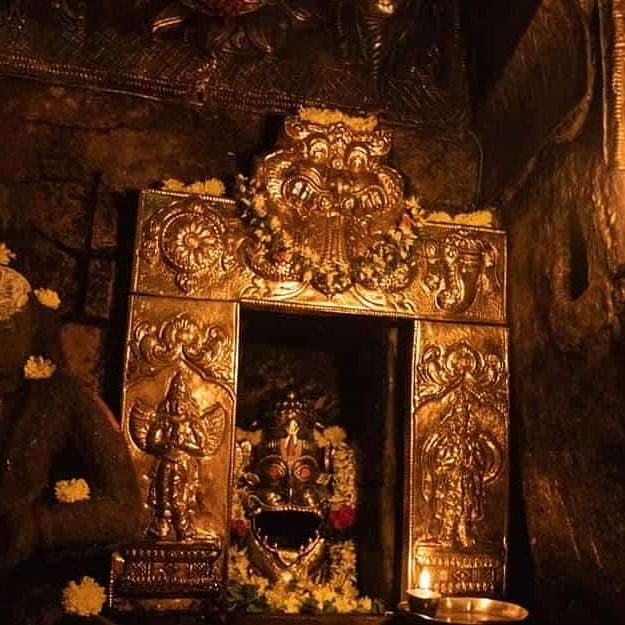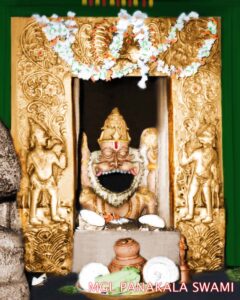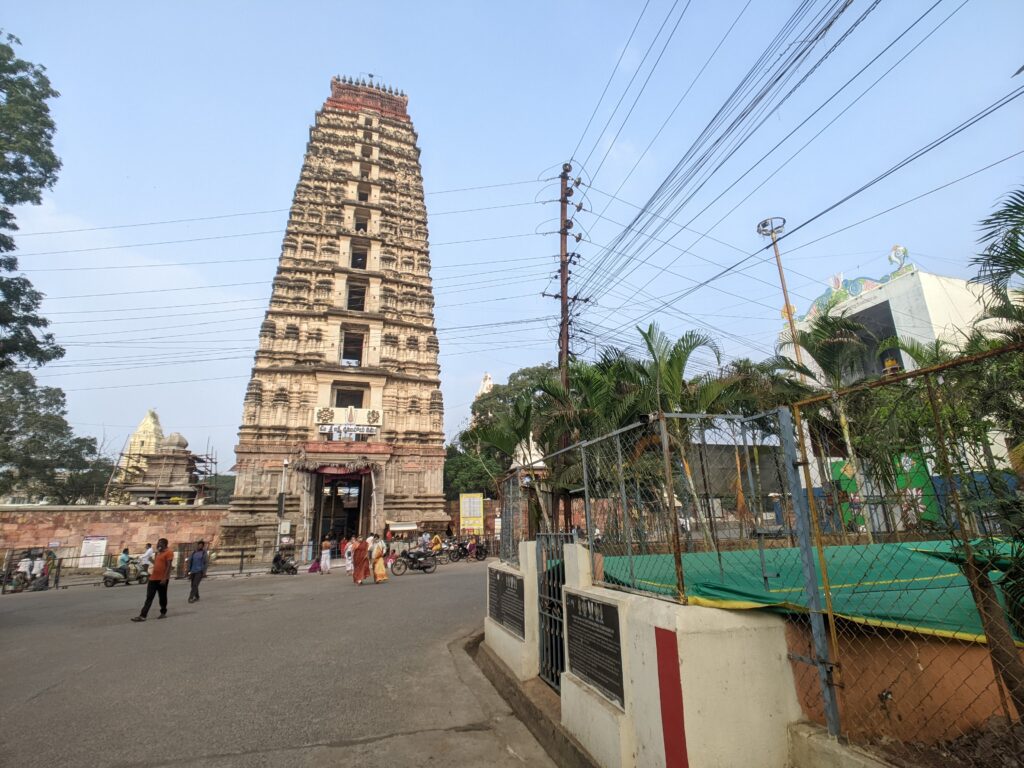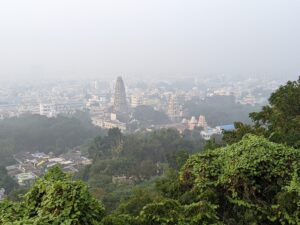
Mangalagiri is one of the Pancha Narasimha Kshetras spread over the Dravida Desam (Telangana and Andhra Pradesh). It is home to Sri Panakala Narasimha Swamy whose temple is on the hill.
Mangalagiri implies ‘auspicious hill’. The hill was named Mangalagiri after Lakshmi Devi performed penances here. There are three Narasimha temples, one at the foot hill, one on the top of the hill and the other in the forest situated on top of the hill.
Mangalagiri temple is famous for the panakam offering which is a mixture of jaggery water with cardamom and other spices. You will be surprised to see the Deity Who is swayambhu i.e. self-manifested and represented by His lotus mouth merely.
Sri Panakala Narasimha Swamy is also known as Sudarshana Narasimha. Located at a short distance from Vijayawada, the Mangalagiri hill is shaped like an elephant. One unique thing about Mangalagiri is the fact that no single ant or fly can be seen around even though huge quantities of panakam is offered to the Lord every day.
History of Mangalagiri Panakala Narasimha Temple
Mangalagiri too has its unique history like the other temples of the Pancha Narasimha kshetras. The following is known about the appearance of Mangalagiri hill:
King Pariyatra had a son by the name Hrasva Srungi, who travelled to many holy places. Hrasva Srungi finally reached Mangalagiri, where he stayed on and performed penances to please Lord Vishnu. The King came here to take Hrasva Srungi back to his kingdom. But instead Hrasva Srungi chose to become a hill in the shape of an elephant and served Lord Narasimha.
The appearance of Panakala Narasimha on Mangalagiri hill
The appearance of Panakala Narasimha here relates to the killing of the demon Namuchi, who was given a boon by Lord Brahma that he would not be killed by anything dry or wet. He turned out to be a threat to the humans on earth as well as the celestial citizens headed by Indra. With the support of Lord Vishnu, Indra set out to kill Namuchi.
When the army of Namuchi was being annihilated by Indra, the demon assumed an extremely small size and hid in a cave. With Lord Vishnu in the center, the Sudarshana Chakra created huge tidal waves and sent them to the cave. Lord Vishnu shut out Namuchi’s life-breath by the fire of His exhalation. Hence, the Lord came to be known as Sudarshana Narasimha too.
The blood of the demon Namuchi filled the pool below the hill. The Lord was in extreme anger after killing the demon. He calmed down after being appeased by the choicest prayers of the demigods and sages followed by the consumption of amrita i.e. nectar.
The Lord declared that He would be happy with offerings of ghee in Treta yuga, milk in Dwapara yuga and panakam in Kali yuga. Thus, He came to be known as Panakala Narasimha in Kali yuga.
Great personalities visit the Mangalagiri Panakala Narasimha Temple
Mangalagiri has been witness to great devotees and well-known personalities visiting the shrine. These include Sri Adi-Shankaracharya, Sri Ramanujacharya, Sri Madhvacharya and Sri Chaitanya Mahaprabhu. The foot-prints of Sri Chaitanya Mahaprabhu are present on the hill.
Many other great kings have visited the temple and contributed to its various aspects. King Krishna Devaraya of the Vijayanagar dynasty had conquered and made Mangalagiri one of the 200 towns of his empire in 1515 CE.
He declared Mangalagiri as devabhoomi or devasthanam bhoomi. He has done many other contributions to the temple. Other kings in India too have contributed.
Deities of Mangalagiri Panakala Narasimha Temple
Sri Panakala Narasimha Swamy is the main Deity of the temple accompanied by Sri Lakshmi Devi. The Deity of Sri Panakala Narasimha is represented by a big mouth covered with a golden mukuta.
The Lord is offered the panakam drink through His lotus mouth. Half of the panakam offered comes back as prasadam. This prasadam is offered to the devotees.
When the panakam goes down the lotus mouth of Lord Narasimha, devotees present near the Deity can hear a gurgling sound. Devotees who receive the panakam prasadam are indeed fortunate!
The small Deity of Rajyalakshmi Devi can be seen in a different cave shrine behind Lord Panakala Narasimha’s temple. Her Deity is present on the cave wall at a height.
A small rock carved Deity of Sri Venkateshwara Swamy can be seen in another cave shrine in the complex. There is a small shrine housing the Deity of Sheshashayi Vishnu. Another rock carved orange coloured Deity of Lord Hanuman can be seen on the wall by the staircase.
Architecture of Mangalagiri Panakala Narasimha Temple
The temple is built using the Dravidian style of architecture. Though the construction is simple in nature, you can see many carved pillars as you enter the temple in the mukhamantapa.
The dwajastambha i.e. flag-pole of the temple can be found at the entrance of the temple. It was erected in 1955. The stone steps to the temple were built by Sri Channapragada Balaramadasu in 1890.
There is a tunnel to the west of Lakshmi Devi’s shrine which has been closed down. This cave is believed to be leading to the Undavalli caves on the banks of the sacred Krishna river. The sages are said to have used this route to go to the Krishna river for their ablutions.
Cheekati Koneru or Sathavarsha Pushkarani
Mangalagiri boasts of another marvel of Architecture which perhaps only Indians could have thought about and executed. This is a small water tank situated on the North Eastern side of Sri Lakshmi Narasimha Swamy Temple. The tank was built in 1912 AD by the great philanthropist Sri Vinjamuri Bhavanachari of Guntur.
At that time the Raja Gopuram of Sri Lakshmi Narasimha Swamy Temple was one of the tallest gopuras in South India. Due to the uneven gravitational pull this Raja Gopuram began leaning towards one side. Sri Vinjamuri Bhavanachari created this water tank which is in the shape of an inverted gopuram (153 feet deep) on the North Eastern side of the temple. This gave a proper balance to the Raja Gopuram thus setting its leaning into a straight line.
Festivals of Mangalagiri Panakala Narasimha Temple
The annual Brahmotsavam is the main festival at the temple. It is celebrated over 11 days beginning from Phalguna Suddha Shashti (Feb – Mar). One day before the Phalguna Suddha Purnima i.e. on Chaturdashi, the divine marriage of Lord Narasimha with Sridevi and Bhudevi is celebrated here as per the Agama shastras.
Before this marriage, the Chenchu tribe celebrates the divine marriage of their daughter Chenchu Lakshmi with Lord Narasimha. The Lord arrives on His Shesha vahana at night and participates in Eduru Kola.
On the next day i.e. Pournami, devotees celebrate Thirunalla, the chariot festival of Lord Narasimha. The Lord goes on a chariot procession attended by around one lakh devotees, both local and distant.
Narasimha Jayanthi, Hanuman Jayanthi, Rama Navami and Vaikuntha Ekadashi are the other major festivals celebrated here.
Temple Timings of Mangalagiri Panakala Narasimha Temple
The temple opens at 7 AM in the morning for darshan and panakam offering. The darshan closes by 3 PM in the afternoon.
There are no further offerings or darshan after 3 PM as the belief is that Sri Panakala Narasimha Swamy is worshiped by the demigods and sages in the evening.
Every Ekadashi, you can have darshan of the Panakala Narasimha nija-rupa (without the mukuta) if you attend the mangala arati in the morning at 5 AM.
How to Reach Mangalagiri Panakala Narasimha Temple
With Tirtha Yatra, you can easily travel to Mangalagiri on the Bhadrachalam Yatra, which exclusively covers all the Pancha Narasimha Kshetras.
Traveling to Mangalagiri is the easiest amongst all the Pancha Narasimha kshetras. As Mangalagiri is located near Vijayawada city, it is easy for devotees from Andhra Pradesh and other states to reach the temple.
Well-constructed roads take you up the hill in vehicles. Those who wish to climb the hill will have to cover 600 steps to the temple.
You can pick any one or combination of the following transportation methods:
By Road: Mangalagiri is only 11.7 kms and 24 kms away from Vijayawada bus station and Guntur city respectively. The distance increases by another six kilometers from Vijayawada city. Buses and private taxis are available from these cities.
By Rail: Mangalagiri railway station 1.5 kms away serves this temple town. Trains from Vijayawada, Bangalore Cantt, Narasapur, Hubli and Guntur stop here. If you are traveling from farther regions, Vijayawada railway station 12.3 kms away is your ideal rail point to reach Mangalagiri.
Buses and private taxis are available for the further journey.
By Air: Vijayawada airport is the nearest to Mangalagiri 30 kms away. You can fly in here and use the road or rail route to reach Mangalagiri.
Mangalagiri: Where the mercy of Sri Panakala Narasimha flows eternally
At Mangalagiri, Lord Narasimha is ever ready to accept His devotee’s offering of panakam. This is depicted in the way the Lord keeps His lotus mouth wide open.
Panakam is usually offered to Lord Narasimha to cool down His anger. At Mangalagiri, the Lord is in a ugra bhava.
Hence, this simple and humble offering satisfies the Lord very much that He gives back half of it as His prasadam. You would not want to wait anymore to drink the panakam of Sri Panakala Narasimsha Swamy.
2














2 Comments On Pankala Narasimha Temple, Mangalagiri
[…] Temple :The Legend of Panakala Narasimha Swamy Temple Located in the center of the Guntur district of Andhra Pradesh, One of the most popular tourist […]
G.B.MANJUNATHA
ಸ್ವಾಮಿ ಪಾನಕಾಲ ರಾಮಸ್ವಾಮಿ ನಾಳೆ ಮುಂಜಾನೆಯೊಳಗೆ ನನ್ನ ಕೈ ಕಾಲಿಗೆ ಶಕ್ತಿ ನೀಡಿದರೆ ನಿನ್ನಯ ದರ್ಶನ ಪಡೆದು ಹಂಡೆ ಪಾನಕದ ಸೇವೆ ಸಲ್ಲಿಸುವೆ ತಂದೆ.